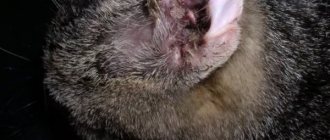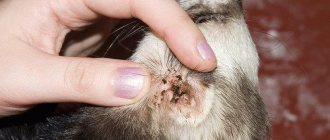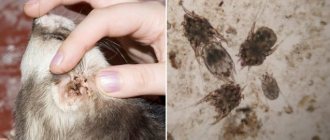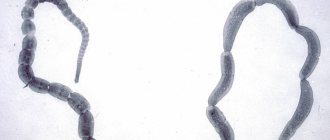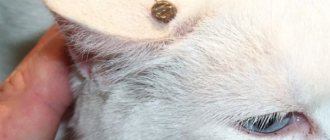What is otodectosis in dogs
Ear mites in dogs are a parasitic disease. With otodectosis, the pathogen settles in the auricle and causes significant harm to the pet through its vital activity. Its food is destroyed epidermis and skin cells. The mite damages the skin inside the ear and causes severe itching and inflammation.
The development cycle of otodectosis pathogens includes 5 phases and takes 20-25 days under favorable conditions. Parasites multiply quite quickly and increase significantly in number, so the disease progresses dynamically. Cases of infection in dogs are registered by veterinarians throughout the year.
Treatment of otodectosis at home
Ticks in the ears of dogs are destroyed with acaricidal preparations: ointments, drops, sprays and injection solutions. All other medications are used to strengthen the immune system and relieve associated symptoms as part of complex therapy.
Treatment is carried out twice with a break of 1 month. During this time, eggs that are immune to acaricidal drugs mature, but do not have time to lay a new colony. The result of treatment is checked by taking tests twice.
Ointments
Ointments are quickly absorbed, so it is difficult for your pet to splash them when shaking his head. These acaricidal preparations are placed in both ears, gently massaging their base. The risk of overdose with this treatment is minimal, but if the eardrum is damaged, it is ineffective.
Drops
The purpose of the drops is similar to ointments. They are used for the purpose of prevention or at the initial stage of the disease. The drops are convenient to dose. They easily penetrate deep into the ears and have an anti-inflammatory and antimicrobial effect.
Special foam
Aerosol foam is easy to apply. Due to the speed and ease of spraying, pets tolerate this treatment very easily. Like previous drugs, foam is used exclusively at the initial stage.
Injections
In case of severe damage, injection solutions are used. They are administered intramuscularly or subcutaneously, achieving the desired effect in a short time.
Folk remedies
Turning to traditional medicine is acceptable - but only as part of complex therapy and as prescribed by a veterinarian. Healer's recipes do not eliminate the true cause of the disease, therefore they are only suitable for smoothing out the symptoms.
In addition to low effectiveness, it is important to note the allergenicity of some herbal preparations. It is also not recommended to use recipes with kerosene, garlic and iodine. These substances are very aggressive. If they come into contact with damaged skin, they cause burns, and if they penetrate the inner ear, they cause deafness.
The safest remedies include green tea lotions, as well as some oils:
- almond;
- camphor;
- olive;
- coconut;
- lavender;
- sunflower.
All these substances are used as an antiseptic before applying the main drug. They soften dried crusts, helping to remove accumulated masses.
What does an ear mite look like on dogs?
The Otodectes cynotis mite is only visible when magnified under a microscope. It belongs to the class of arthropods from the chelicerate subtype. This parasite has a flat, oval body. Its size does not exceed 0.5-0.7 mm. It has a gnawing mouthparts. The parasite's legs are short, the fourth pair is underdeveloped. Due to its beige color, it is practically invisible on the skin. Externally, ear mites in dogs resemble a small spider.
The female lays about 5 eggs per day on the surface of the ear canal. After 4 days, larvae appear, go through 2 nymphal stages and eventually become adult ticks. The entire process takes about three weeks.
Hygiene and care - how to rinse your ears before instilling medications
Before instilling medications, the ears must be cleared of accumulated secretions. Dried crusts and scabs are soaked with hydrogen peroxide, furatsilin or herbal infusion (see above). The antiseptic is applied strictly to a cotton swab, since the disc can accidentally push the purulent mass into the sink.
At first, it is better to enlist the help of a friend and put a muzzle on your pet. A small dog can be wrapped in a towel.
While processing, work from the inside out, being careful not to go too deep. Wash your hands thoroughly after each procedure and purchase an Elizabethan collar that prevents scratching of damaged areas.
Causes and routes of infection
To prevent the pet from having to be treated in the future, owners must understand exactly how ear mites are transmitted in dogs and how they become infected with this parasite.
In a pet, ear scabies infection occurs in the following cases:
- prolonged or fleeting contact with an infected animal;
- using water/food bowls or bedding that was used by an infected dog;
- a person who has been in contact with an infected animal brings the pests home on clothes or shoes;
- fleas carry mite larvae that cause ear scabies;
- transmission from the mother - this is how ear mites appear in a puppy.
Infection between animals occurs at any stage of the tick's life cycle. When a dog experiences itching, it begins to scratch its ears intensely and shake its head, which contributes to the spread of the parasite. Taking this into account, an adult tick or its other forms at any stage of development can be found in different places where a pet lives.
Most often, puppies aged 1.5-4 months suffer from otodectosis. Dogs with long ears (dachshunds, spaniels, Yorkies) are also more susceptible to this disease. Representatives of hunting breeds also belong to a special risk group. They can become infected with ear scabies both from relatives and through contact with wild animals.
Treatment of a kitten and a pregnant cat
You should choose drugs for the treatment of otodectosis in very young kittens and pregnant cats more carefully. Folk remedies can be called completely safe, but they can only help with mild, non-advanced forms of the disease. When studying the range of industrial drugs, you should choose those that are not absorbed into the blood.
The drug Stronghold, which is applied once, is approved for use in pregnant cats. It is low-toxic and, subject to dosage, absolutely safe. It is approved for use in kittens from 6 weeks of age. For babies, you should choose drops in lilac-colored packaging, and for adults, blue ones.
Another safe remedy for the treatment of ear scabies in pregnant and lactating females is the drug Frontline Spot On. It does not enter the animal’s blood, but is distributed in the epidermis and sebaceous glands. For kittens from the first days of life you can use Frontline Spray.
You should carefully choose medications for the treatment of ear scabies in kittens - some of them can harm your furry baby
Symptoms
How can you tell if your dog has ear mites? From the moment of infection to the appearance of primary symptoms, 1.5-2 weeks pass. If you notice the signs of ear mites in dogs in a timely manner, you will be able to avoid complications and it will be easier to get rid of the pathology.
If otodectosis is present in dogs, the symptoms will be as follows:
- At the beginning of the development of pathology, mild itching develops.
- Over time, the animal's anxiety increases. The dog begins to rub its ears with its paws, dynamically shakes its head, runs from side to side, whines or barks.
- Dark brown exudate with an unpleasant odor accumulates in the ears. Gradually it dries out, forming crusts.
- Due to numerous paw blows to the auricle, hematomas may form on it, requiring surgical treatment.
- The pet can seriously scratch and damage the skin of the ear. In the area of scratching, the skin becomes swollen and reddened.
- The animal loses its appetite, becomes irritable and restless.
Advanced otodectosis is complicated by infection of the external auditory canal, which over time can spread to the middle and inner ear. The nature of the lesions will directly depend on their degree.
In more severe cases of ear mites in dogs, symptoms include ulcers, abscesses, and perforated eardrums. If such complications of otodectosis are not treated, then inflammation can spread to the membranes of the brain - symptoms include seizures, paralysis and can lead to the death of the pet.
How to recognize the disease
The disease in a dog is indicated by external signs of ear mites, affecting exclusively the ears, as well as accompanying symptoms. If at least two of them are detected, you must immediately make an appointment with a veterinarian to avoid irreversible consequences of the disease.
External signs
As a result of inflammation, a brownish or almost black mass with a fetid odor accumulates inside the sink. It consists of sulfur, pus, particles of the epidermis and waste products of mites.
The outer part of the ear becomes red and swollen. The animal itches constantly, so scratched wounds become covered with bleeding scabs. Bald patches form in damaged areas. Due to the accumulated secretions, the hairs near the ears stick together, giving the coat an unkempt appearance.
Associated symptoms
In addition to scabies, frequent shaking of the head, nervousness and aggression are observed. A sick dog actively itches not only with its paws, but also with any objects found in the house.
When shaken, part of the brownish mass may fly directly onto the floor. The animal accompanies all its actions with whining or growling.
As the disease progresses, symptoms are complemented by increased body temperature and deterioration of hearing. The most dangerous symptoms include seizures. They occur when the brain is damaged and can be fatal.
Diagnosis of otodectosis in dogs
Before prescribing treatment for otodectosis in dogs, a veterinarian must evaluate the signs of the disease. You should not delay your visit to the veterinary clinic. For otodectosis, diagnosis includes:
- Examination of the outer and middle ear using an otoscope.
- Collection and microscopy of material from the ear canal.
- In severe cases, X-ray or CT scan to determine the condition of the lower parts of the hearing organs and meninges.
Additionally, diagnostic procedures such as cytological examination of material from the ear canal and allergy tests may be prescribed. All this will help the doctor make a correct diagnosis and select drugs that are optimally suited in a particular case. After all, whether the therapy will be successful depends on how to treat ear mites in a dog.
Diagnosis of Otodectes cynotis
To help your pet, you need to show it to a dermatologist who will conduct an external examination and take a smear of the contents from the ear for microscopic examination and cytological analysis. During the appointment, the inside of the ear canal is examined for the integrity of the eardrum. It is also necessary to exclude diseases that can provoke complications - otitis externa, various formations of the ear canal, foreign bodies and much more. All this is necessary so that the doctor can correctly select antimicrobial and anti-inflammatory drugs for treating the pet.
Treatment of ear mites in dogs
A veterinarian must select treatment for otodectosis in dogs, and also decide whether it will be one remedy or whether complex treatment is required. The specialist takes into account the stage of the disease, concomitant pathologies, size and age of the pet. Treatment with folk remedies for ear mites in dogs is not recommended. Often such actions lead to progression of the disease, severe complications or death of the animal.
Most often, treatment for otodectosis in dogs includes:
- Cleaning the dog's ear canal from mite waste products. It is important to soften and carefully remove all crusts. It is better to entrust this to a specialist, especially for ear mites in puppies. Based on the anatomy and physiology of the dog’s hearing organs, the doctor will do everything right without aggravating the animal’s condition. Dogs do not like this procedure and may resist. Especially with advanced otodectosis, treatment at this stage can cause pain to the pet.
- After cleansing the ear canal, the animal is prescribed an antiparasitic drug. Medicine for ear mites in dogs and other accompanying medications, if necessary, are prescribed by a veterinarian after assessing the animal’s condition. Pets are often prescribed special drops for otodectosis.
Veterinary specialists are well versed in medications and know how to treat severe otodectosis in dogs. Complex therapy may include: antibacterial, anti-inflammatory and antifungal drugs, anti-parasitic drugs. A remedy for ear mites in dogs should have a high therapeutic effect and be easy to use.
Only a doctor can recommend or cancel any manipulations or remedies, since he probably knows how to completely get rid of ear mites in a dog. To avoid having to start treatment all over again, it is important to listen to and follow the recommendations of your veterinarian.
Often infected pets are prescribed anti-otodectosis drops for dogs. There are quite a few such products on sale, but you should not select them yourself. Especially if the puppy has ear mites, because it is the veterinarian who should advise how to treat the baby. Treatment, medications, and prices for ear mites in dogs can vary greatly. Before using this or that product, it is important to carefully read the instructions.
For otodectosis, many medications are recommended to be instilled into both ear canals of the dog 1-2 times a day for several days. Such preparations for ear mites in dogs can cause discomfort to the animal due to inflammation of the skin of the ear canal and be inconvenient for the owner due to the need to spend a lot of time on such treatments.
How does Stronghold work?
Ear mites in dogs can be treated using Stronghold drops. The active ingredient in them is selamectin, which has a wide spectrum of antiparasitic effects. This product is sold in pipettes of various sizes for dogs and cats of different weights. It is quickly absorbed at the site of application and has a systemic effect.
The instructions for the drug indicate how to remove ear mites from a dog with its help.
For otodectosis, Stronghold is applied once to the dry skin of the animal in the withers area. Along with this, the ear canal is cleaned of exudate and scabs. If the situation is complicated by the development of otitis, then additionally use antimicrobial and anti-inflammatory drugs, which will be prescribed by a veterinarian. After 4 weeks, Stronghold drops can be reused.
Stronghold is well tolerated by animals from the age of 6 weeks and has no weight restrictions. These drops are well tolerated by a variety of dog breeds, including collies and other breeds with a defect in the MDR-1 gene. But it should be remembered that any treatment, including treatment for ear mites in dogs, must be selected by a veterinarian.
How to put drops in a dog's ear
Treatment of otodectosis using drops has its own characteristics. First of all, both auditory organs of the animal are treated, even if only one is infected. Before applying the medicine, study the instructions. Attention is paid to dosage and contraindications.
The procedure is carried out in several stages:
- Fix the dog's head in a stationary position.
- Bend back the edge of the ear.
- Drop the medicine in the volume specified in the instructions.
- Using massage movements, distribute the drops evenly.
Prognosis and prevention
The diagnosis of ear mites in dogs, its symptoms and treatment should be discussed with your veterinarian. If this is done in a timely manner, the prognosis is favorable and the disease responds well to therapy. It is important to prevent the spread of the inflammatory process to the lower parts of the hearing organ. If the condition is aggravated by the development of meningitis, then the pet’s chances of recovery become minimal.
You can protect your animal from infection with ear scabies. For this purpose, preventive regular treatment of the dog with antiparasitic drugs, such as Stronghold drops, is recommended. For this purpose, the drug is applied to the animal’s skin monthly. Additionally protecting the dog not only from ear mites, but also from fleas, lice, lice, scabies, roundworms and heartworms.
In addition to regular treatment, there are a number of preventive measures that also help reduce the likelihood of developing the disease:
- avoiding contact between your pet and stray animals;
- systematic examination of the dog’s ears;
- regular preventive visits to the veterinary clinic;
If you follow these simple rules, then infecting your dog with otodectosis will not be relevant. Take care of your pets, because prevention is always more effective than any treatment!
Read also
Subcutaneous mite in a cat (Demodicosis)
Cats of different breeds and ages, both domestic and outdoor, can suffer from this disease.
Worms in cats: symptoms, signs and treatment
The first signs of infection may be absent for some time or resemble manifestations of other diseases
Sterilizing a cat: at home or in the clinic?
Sterilization is an intervention as a result of which an animal (a cat in particular) loses its ability to reproduce
Symptoms and signs of rabies in a cat
A person becomes truly afraid only when a cat bites him until he bleeds.
Ringworm in a cat: Treatment and symptoms
Ringworm is a serious infectious disease. When a cat gets sick itself, it transmits the disease to its owners.
Possible complications
In addition to meningitis, the animal may also face other dangerous complications. These include:
- partial or complete deafness;
- dermatitis and allergies;
- purulent otitis;
- weakening of the body's defenses against the background of extensive intoxication;
- secondary infections;
- formation of ear plugs;
- inflammation and rupture of the eardrum.
Remember that puppies and older dogs tolerate the disease much worse than healthy animals. Because of this, they often die from the consequences in a very short time.
